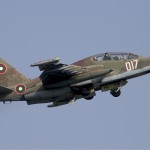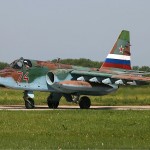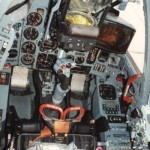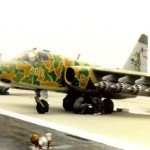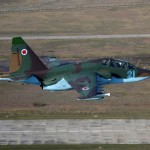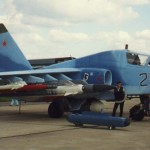
The Russians called the Su-25 “Grach” (Russian for “Rook”) and NATO calls it “Frogfoot.” It is, in many ways, the opposite of the Su-24 “Fencer,” which is also designed for ground attack. The Su-24 is sleek and supersonic, with variable-sweep wings and a $30 million pricetag. The Frogfoot is slow, fat, fixed winged, and costs only $11 million. One thing they share: both are still in wide use throughout the former Soviet bloc.
But don’t let looks fool you. The Su-25 is not a standoff, long-range missile truck. It is designed for low-altitude suppression of enemy armor and anti-aircraft weapons, and it has been an effective and dependable workhorse of many air forces for more than 30 years. More than 1,000 have been built, and few have ever been confirmed to have crashed. (Many have been lost in combat, of course, and a Russian Air Force Su-25 was accidentally shot down by its wingman near Vladivostok in 2008.)
The Su-25 is meant to travel slowly through a battlefield to engage ground targets with guns, rockets, bombs and missiles at close range from 11 external hardpoints. It has heavily armored and can withstand direct hits while remaining operational.
In 1969, responding to American interest in close air support, the Soviets held a design competition for its new close-support aircraft. The Sukhoi T-8 project beat out Yakovlev, Ilyushin and Mikoyan. The T-8 would eventually become the Su-25.

The Soviet Air Force Su-25s saw their first combat during the Soviet war in Afghanistan in the 1980s. The Su-25 was used to conduct air strikes against Mujahideen positions in the mountains. At peak, Su-25’s were averaging one sortie per day. In eight years in Afghanistan, 21 Su-25s were lost to hostile fire.
Iraq purchased a reported 73 Su-25s during the Iran-Iraq War. Ironically, several Su-25 pilots fled to Iran at the start of the Persian Gulf War, and Iran seized the planes as “gifts” from Iraq. The Su-25 did not have any combat success during the Persian Gulf War, with the plane’s only combat action coming when two were shot down quickly by American F-15Cs. By 1998 Iraq was still reported to have 12 Su-25s. Three Su-25K export craft were seen in a demonstration over Baghdad in 2002, but the Su-25 has not been used by Iraq since the 2003 invasion by the American-led coalition.
Today, the Frogfoot remains in active service in no fewer than 20 air forces including the Peruvian Air Force, which has conducted successful drug interdictions with the Su-25, and the Ukrainian Air Force, which operates dozens of Su-25s. The Frogfoot was widely exported to African nations also. Congo has had the worst luck with the airplane. In 1999, the Air Force of the Democratic Republic of the Congo purchased 10 Su-25s. Two crashed in non-combat circumstances, and one mysteriously vanished in 2007 and was never found.
While they were developed around the same time and are meant for similar missions, the American A-10 is vastly different than the Su-25. The A-10 is much larger, and the Su-25 does not have the size, armament, or survivabiltiy (through design or redundant systems) that the A-10 has.
On June 12, 2012, a Belarusian Air Force Su-25 crashed, killing the pilot. Local news reports indicated the pilot was ordered to eject but stayed to direct the plane away from a populated village, sacrificing his life.
Russia plans to keep the Su-25 in service until at least 2020, when a similar-but-advanced replacement is due.
In popular culture, the Dos computer game Su-25 Stormovik is based on the Frogfoot. The game featured amazing graphics for its time but was marred by clunky keyboard-only controls.
Specifications
General
Crew: One
Length: 50 ft 11 in.
Wingspan: 47 ft 1 in.
Height: 15 ft 9 in.
Empty weight: 23,677 lb.
Max. takeoff weight: 45,194 lb.
Engine: 2x Tumansky R-195 non-afterburning turbojets, 9,480 lbf. each
Performance
Maximum speed: 590 mph, Mach 0.77
Range: 1,553 mi.
Ceiling: 23,000 ft.
Thrust/weight Ratio: 0.51
Armament
- 1 GSh-30-2 30mm cannon with 250 rounds
- 11 hardpoints for up to 9,700 lb. of ordnance, including:
- air-to-air missiles for self-defence
- bombs
- cluster bombs
- gun pods
- rockets
- air-to-surface missiles
Essential Reading
There are several good, hardcover books for enthusiasts. Sukhoi Su-25 Frogfoot: Close Air Support Aircraft by Yefim Gordon is a fairly recent (2004) example.
Check out “The Soviet Union’s Tank-buster” also by Yefim Gordon as well.
Online resources:
- Wikipedia — Good article. Well-sourced. Great for reading about Su-25 variants and countries of service.
- Aviation.ru — Some great battle stories of the Su-25.
- Fas.org
